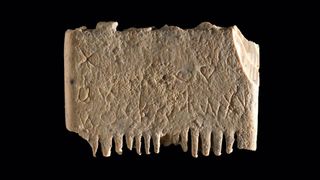One of the oldest written sentences on record blasts hair and beard lice
Even Canaanites hated head lice, hidden message on comb reveals.

One of the oldest known sentences ever written was a plea against contracting lice, a new study has found.
Archaeologists made the hair-raising discovery several years after unearthing a hair comb, which they found in 2016 at an Israeli archaeological site called Tel Lachish, located south of Tel Aviv. The site was once a city inhabited by the Canaanites, who lived in what is now Syria between 3500 B.C. and 1150 B.C., during the Bronze Age.
Made of ivory, the pocket-sized comb measures less than 1.5 inches long (3.8 centimeters) and 1 inch (2.5 cm) tall. One side contained six teeth, which were likely used for untangling hair, while the other had 14 finer teeth for removing lice and their eggs, the researchers said. All of the comb's teeth have broken off over time, but researchers did find the partial remains of head lice on its second tooth, according to the study.
It wasn't until last year that Madeleine Mumcuoglu, a researcher at The Hebrew University of Jerusalem, where the piece has been stored, noticed symbols chiseled into the comb. Using the zoom function on her smartphone, she was able to get a close enough image to decipher the cryptic message, which read, "May this tusk root out the lice of the hair and the beard."
The hidden plea was written in the language of the Canaanites, which preceded Latin, making it the oldest written language with an alphabet in history, as it was the "first alphabet in the world from which most of the modern alphabets, including the Latin alphabet, descend," study first author Daniel Vainstub, an epigrapher at Ben-Gurion University, told Live Science in an email.
Related: 3,000-year-old Canaanite temple discovered in buried city of Israel
"For the first time we have a complete sentence in a Canaanite dialect," he added. "We know dozens of Canaanite inscriptions, but all of them hold two or three words. Now we have a complete and clear sentence that allows us to see the language, the grammar, the syntax, etc. and compare it with other Semitic languages like Biblical Hebrew."
Sign up for the Live Science daily newsletter now
Get the world’s most fascinating discoveries delivered straight to your inbox.
Archaeologists were unsuccessful in radiocarbon-dating the comb, but they were able to narrow down its age, since "the [Canaanite] alphabet was invented in the 19th century B.C., and this inscription most probably should be dated to the 17th century B.C.," Vainstub said.
There's no indication of the comb's owner, but researchers think it may have belonged to a wealthy individual, considering that it came from an elephant tusk. Canaan didn't have any elephants during that time period, so the material likely came from Egypt, according to a statement.
"Ivory was a very expensive and exclusive material," Vainstub said. "Undoubtedly the comb belonged to a wealthy man."
The translated version of the study was published Oct. 12 in the journal Jerusalem Journal of Archaeology.

Jennifer Nalewicki is a Salt Lake City-based journalist whose work has been featured in The New York Times, Smithsonian Magazine, Scientific American, Popular Mechanics and more. She covers several science topics from planet Earth to paleontology and archaeology to health and culture. Prior to freelancing, Jennifer held an Editor role at Time Inc. Jennifer has a bachelor's degree in Journalism from The University of Texas at Austin.
Most Popular


